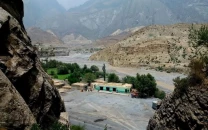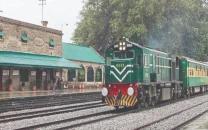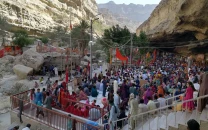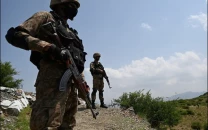Balochistan running out of water
The underground water level is falling with each passing day

The scarcity of water in Quetta and other parts of Balochistan is the most serious problem faced by the dwellers. Almost all districts of the province have been running out of water with the underground water level going down each passing day.
In the last two decades, most of the lush green pastures of Balochistan have turned into deserts due to lack of water.
“Quetta city can also turn into a desert if proper steps are not taken to control the depleting underground water table,” Dr Faiz Kakar, the former head of the International Union for Conservation of Nature (IUCN) Balochistan chapter told The Express Tribune.
The water level continues to deplete fast in Quetta, Pishin, Killa Abdullah, Kalat, Mastung, Khuzdar, Loralai and other districts of the province.
“Scarcity of water will force residents of Quetta to migrate to other parts in the future,” Kakar warned.
Unlike other parts of Pakistan where rivers fed by glaciers exist, in Balochistan, most of the people are dependent on underground water for drinking and agriculture purposes.
However, some experts are of the view that the construction of dams would help maintain the depleting water table. “Construction of dams by the federal and provincial governments in Quetta and other district is a step in the right direction,” Engineer Barakatullah Kakar, an expert on water maintained.
In view of the scarcity of water, the Supreme Court of Pakistan had directed the provincial and federal governments to ensure the completion of construction of all delays and check dams within three years.
The court passed this order in September 2020.
“We are going tooth and nail to ensure completion of dams as directed by the apex court,” Kakar said.
People have been pumping water through tube wells for drinking purposes and agriculture.
This has resulted in fast depleting the underground water table.
People continue to pump water from more than 1,000 feet deep as compared to 200 to 300 feet in the near past.
Muhammad Khan Lehri, the Balochistan Irrigation Minister, informed that currently, work was in progress on the construction of more than 100 dams to maintain the depleting water table.
“We fully understand the sensitivity of the situation,” Lehri observed.
Scarcity of water has forced farmers to abandon their fruit orchards. The number of orchards has considerably decreased in northern and central Balochistan, famous for the production of apples, grapes, and other fruits.
Water shortage has left thousands jobless across the province.
“Growers have cut their fruit trees to use it as firewood due to the lack of water,” Syed Abdul Qahar Agha, the central leader of Balochistan Zamindar Action Committee said.
He shared that most of the people in Balochistan are dependent on agriculture and livestock sectors. However, he complained that successive governments failed to promote the two key sectors of provincial economy of the province and county as water is a must for both the sectors.
In Quetta, the number of WASA tube wells is less than 400. Around 100 tube wells are not functional because of various reasons, an official of the WASA told The Express Tribune.
He requested anonymity because he was not authorized to speak to the media. Thousands of illegal tube wells have been operating on the outskirts of the city to meet the water demand.
“We are providing water to more than 80 per cent population of the city,” Attiq Kakar, a leader of the Water Tankers Association said.
Published in The Express Tribune, May 7th, 2022.



















COMMENTS
Comments are moderated and generally will be posted if they are on-topic and not abusive.
For more information, please see our Comments FAQ